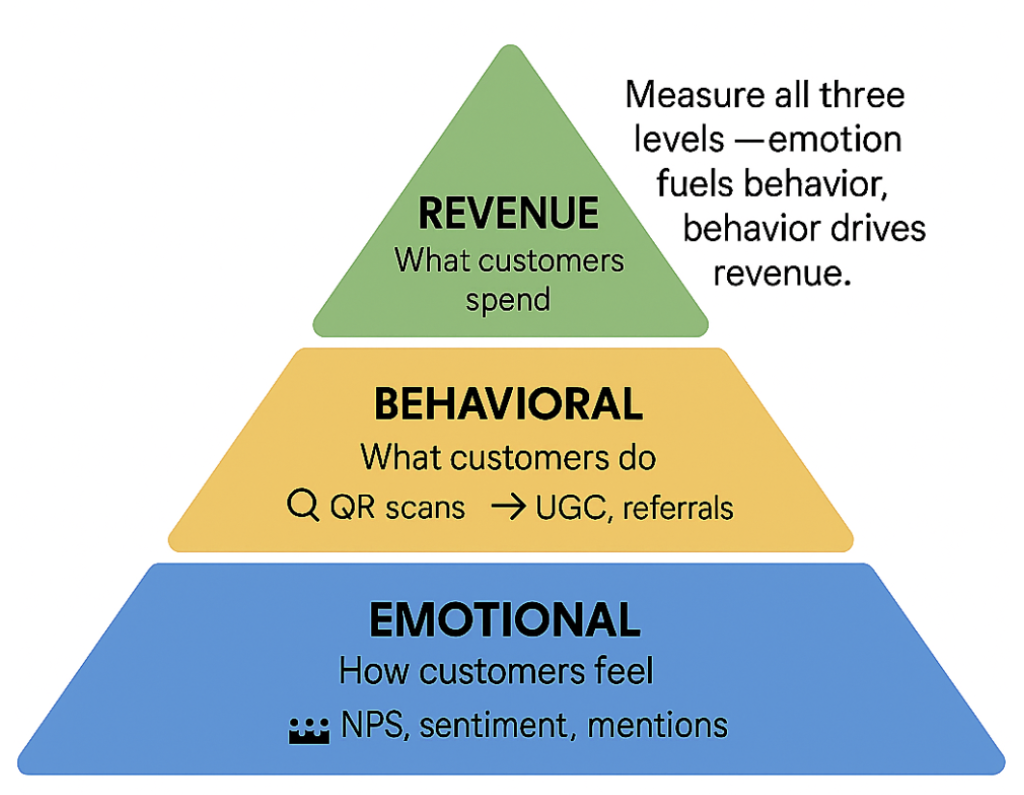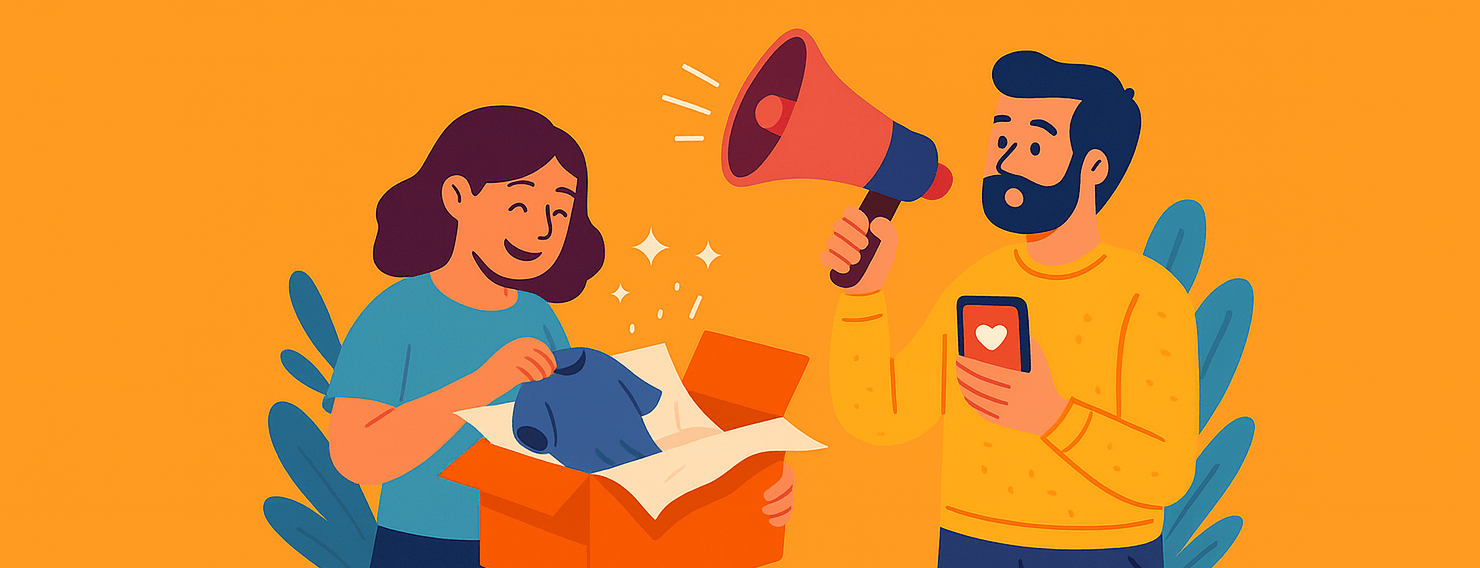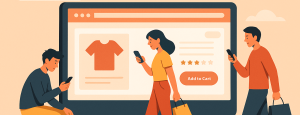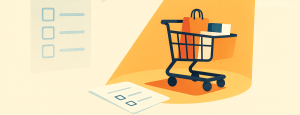You analyse ad spend, CAC, and retention, but what about the moment they open the box?
For most ecommerce brands, the unboxing experience still sits in the “operations” column – a cost to be managed, not a moment to be maximized. The irony? It’s one of the few times your customer is completely focused on your brand, with no distractions, no competing tabs, no noise, just your product and their anticipation.
According to a 2024 U.S. consumer survey, 47% of shoppers said that a premium unboxing experience made them more excited to open the package, and 41% said it made them more likely to buy from that brand again. Those aren’t vanity numbers; that’s loyalty being shaped in real time, right at the doorstep.
Yet, most brands still spend thousands tweaking ad creative or checkout flows while their packaging – the very first physical impression of the brand – goes overlooked.
If you optimise your funnel from click to checkout but ignore the unboxing moment, you’re leaving one of your easiest retention levers untouched. That moment, when the box opens and emotion peaks, is where a one-time transaction can quietly turn into a long-term relationship.
Key Takeaways
- Treat packaging like a marketing asset, not an operational cost. It’s the only touchpoint with 100% customer attention, and it can drive measurable retention.
- Record real unboxings, read packaging mentions in reviews, and benchmark shareability. You can’t optimise what you haven’t observed.
- Build around four behavioural triggers: anticipation, personalisation, discovery, and utility. One emotional + one functional trigger per box is enough to convert delight into action.
- Add a scannable element (QR or NFC) that links to your loyalty hub, referral flow, or post-purchase survey. Connect the physical excitement to digital data.
- Track three tiers of ROI: emotional (review sentiment, NPS lift), behavioural (scan rate, UGC volume) and revenue (repeat-purchase %, AOV, CLV). Redesign without metrics is an expense, not an investment.
- Real sustainability (transparent materials, minimal waste) is now a loyalty driver.
Why the Box Became a Marketing Channel
In a digital world where product listings often look identical, PPC ads blur together and discount fatigue is real, brands have been scrambling for ways to stand out. The inbox is crowded, social feeds are noisy, and trust is harder to earn. That’s why brands are turning back to something refreshingly simple: the physical experience that customers can feel.
This is what marketers are now referring to as the “fulfillment-to-retention gap.” Checkout happens online, but loyalty starts offline, right when the package lands. That short unboxing window is your bridge between transaction and emotion.
So why does this moment matter so much? Behavioral psychology explains why it works: it taps into three well-documented effects that turn emotion into memory.
- Anticipation bias: The joy starts before the reveal. Customers feel a hit of dopamine just from expecting something good.
- Ownership effect: The second they touch the product, its value increases in their mind. It’s not a purchase anymore; it’s their purchase.
- Memory encoding: The textures, sounds, and visuals of unboxing create sensory anchors that make the experience more memorable (and repeatable).
Put simply, the unboxing experience is where logic meets emotion, and emotion drives loyalty.
Once you understand why that first tactile moment matters, the next question is: how do you design it to tell your story?
From Brown Box to Brand Canvas
What used to be “just a shipping box” has quietly become one of the most powerful storytelling tools in ecommerce. Think about it: your customer’s journey starts in pixels – scrolling, clicking, comparing – but it ends in the physical world, with a package in their hands. That’s where your brand finally becomes real. Great packaging doesn’t simply protect what’s inside. It extends your digital brand into the tactile world, which some call tactile branding.
Tactile branding is all about design continuity. It means that the tone, color, and care your customer experiences online flow naturally into what they feel offline. The fonts, textures, the unwrapping sequence, they all reinforce your identity in a way screens never could.
Some of the most successful DTC brands have mastered this:
- Apple is often cited as a benchmark for packaging mastery. Its design teams famously prototype every layer of the unboxing process, even studying the “perfect friction” of how the lid lifts off, to create a sense of precision and calm that mirrors the product inside.
- Glossier built one of the most recognizable packaging identities in modern retail. Its millennial-pink bubble pouch became so iconic that the company trademarked it, turning a simple protective mailer into a signature part of the customer experience.
- Allbirds extends its sustainability message to every touchpoint, including packaging made from post-consumer recycled cardboard and printed with soy-based inks (check the Dasher model below). Even the unboxing moment feels tactile and natural, echoing the brand’s promise of “better things in a better way.”
- Ritual uses minimal, transparent packaging that reflects its philosophy of clean ingredients and clear labeling. It visually reinforces the company’s commitment to transparency – you can literally see what’s inside.

It’s no coincidence that these brands are also among the most loved. The box, quite literally, shapes how people judge your brand before they even try the product.
So how do you make that leap from digital tone to physical form?
- Fonts: Use the same typography your brand uses online to maintain recognition and continuity.
- Inserts: Keep copy short, human, and on-brand, whether that’s witty, calm, or confident.
- Voice: Write as if you’re speaking directly to the person opening the box. No corporate fluff.
- Minimal copy: Don’t clutter. Let your visuals and textures do the talking.
- Texture hierarchy: Pair soft-touch or matte finishes with small tactile contrasts to create moments of sensory surprise.
This way, packaging becomes your brand’s first handshake – warm, intentional, and unmistakably you. It’s the one marketing touchpoint that doesn’t scroll past, it lingers, it lives in someone’s home, and it keeps reminding them why your brand feels different.
When Customers Become the Camera Crew
Here’s where the power of unboxing kicks in: when your customers start doing your marketing for you. A great unboxing doesn’t just make people happy, it makes them want to share that happiness. It’s the start of what you could call the UGC flywheel:
thoughtful packaging → emotional response → shareable moment → organic reach → new buyers.
And it’s not a small phenomenon. User-generated content drives 6x higher engagement than brand-created content. Meanwhile, 79% of shoppers say UGC “highly influences” their buying decisions. That means every shared unboxing clip or photo has a direct impact on purchase behavior.
Here’s how other brands have turned packaging into performance:
- Oodie built an entire social presence around its customers. Most of its TikTok ads aren’t ads at all; they’re cozy, funny, authentic videos of real customers unboxing and reacting. Oodie just amplifies what’s already happening organically.
- HelloFresh didn’t need to invent a content strategy; its customers did. Their bright, photo-ready recipe kits practically beg to be filmed, and “#HelloFreshUnboxing” now has millions of views.
- Function of Beauty adds personalized name labels to every bottle of shampoo. It’s subtle, but genius. Who wouldn’t want to post a product that literally has their name on it (and is also customized for their needs)?

The secret behind this kind of organic reach is engineering shareability. You don’t have to ask customers to post, you just have to design a moment worth sharing.
Here’s how to do it:
- Layered reveals: Each step of the unboxing should build curiosity and anticipation. Think of Apple’s signature “lift and pause.”
- Personal touches: A handwritten thank-you note, name tag, or personalized insert makes the moment feel worth capturing.
- Visual triggers: Stickers, tissue patterns, or brand colors that pop on camera increase postability.
- QR codes with purpose: Link to a short “thank you” video, a loyalty reward, or even a “share your unboxing” challenge with a branded hashtag.
When you make the packaging experience feel intentional and fun, customers become your best storytellers. Their videos, photos, and reactions build trust far faster than polished brand ads ever could, because they’re real.
And the best part? Every shared post becomes a ripple. It reaches new audiences, reinforces your brand personality, and turns every box you ship into a potential marketing campaign, one that runs itself.
Sustainability as a Loyalty Signal
Shoppers can spot “greenwashing” a mile away, and what they really want isn’t packaging that looks eco-friendly, but one that genuinely is.
According to a consumer survey by Packaging Technology Today, 60% of respondents said that eco-friendly packaging influenced their decision to purchase from a brand. That means your materials, messaging, and even your disposal instructions play a direct role in whether customers buy again.
Here’s how to turn sustainability into a loyalty signal, not just a marketing slogan:
- Highlight materials clearly. Instead of vague claims like “eco packaging”, be specific: “Made with 80% recycled cardboard and printed with plant-based inks.” Customers appreciate honesty more than perfection.
- Replace filler with storytelling. Ditch the unnecessary paper or plastic wrap and add a small info card or QR code linking to a short sustainability story. Show where your materials come from, how they’re sourced, and what impact the customer makes by choosing your brand.
- Avoid “brownn fatigue”. Just because it’s sustainable doesn’t mean it has to look dull. Minimal can still be premium. Play with texture, typography, and contrast – embossed logos, bold black-on-kraft designs, or even a single signature color. Sustainability should signal care, not compromise on creativity.
Think of Aesop’s minimalist bottles, Wild Deodorant’s sleek refillable cores, or Patagonia’s no-frills boxes that proudly wear their purpose on the outside. Each brand proves you can be both sustainable and distinctive, and that responsibility can be a design language of its own.
Packaging as a Retention Lever: Closing the CX Loop
Let’s be honest, delight is great, but it’s not the finish line. A beautifully packaged order might make someone smile once, but unless it leads somewhere, that joy fades fast. With a few smart tools – inserts, QR codes, or NFC tags – your packaging can close the customer experience (CX) loop and turn a single purchase into a relationship.
Here’s how:
- Loyalty dashboards: Add a QR code that says “Your order earned 200 points – see what you can unlock.” Instant gratification meets ongoing engagement.
- Referral programs: A small card that invites customers to share their love – “Give 10%, get 10%” – can turn fans into advocates.
- Feedback surveys: A one-question NPS or CSAT link right after unboxing captures authentic sentiment while the experience is still fresh.
- Reorder shortcuts: For repeat-purchase items (like coffee, skincare, or pet food), an NFC tag or QR code that opens a pre-filled reorder page saves customers’ effort and keeps them coming back effortlessly.
Here’s what that can look like in practice:
Scan QR → Thank-you page + reward → Data capture (email, survey, referral) → Next-order trigger.
That short journey connects emotional delight (the unboxing high) with behavioral triggers (loyalty, feedback, or repeat orders). But, we’ll get into more detail in a bit.
The 10-Minute Audit: Find Your CX Gaps
Before you start redesigning your packaging or sourcing new materials, take a breath. You might not need a full overhaul. What you do need is a quick, honest look at how your current unboxing experience feels to a real customer.
Here’s a 10-minute audit you can run today – no consultants, no budget, just clarity:
- Does the physical packaging reflect your digital brand?
If your site feels sleek, modern, and eco-friendly but your box looks like it came from a warehouse clearance sale, that disconnect affects trust. The unboxing experience should feel like a natural continuation of your online identity, with the same tone, colours, materials, and level of care. - Film a few real unboxings. Ask friends, colleagues, or loyal customers to record themselves opening your product. Don’t script it, just watch their reactions. Do they smile? Do they pause to appreciate something? Or do they just rip and toss? Their expressions will tell you more about your CX quality than any spreadsheet ever could.
- Would anyone share this on social?
Nearly 16% of consumers say they’d share a photo of their online order if it arrived in a unique, branded box. That’s free organic reach, no ad budget required. So ask yourself: does your packaging look shareable? Would someone actually take a photo of it because it feels special, fun, or aesthetically pleasing?
The first step in improving your unboxing experience is awareness. Record, review, and reflect before you redesign.
Takeaway: You can’t optimise what you haven’t observed. Start by diagnosing your unboxing like you would a landing page. Test it, watch it, and listen. The insights will tell you exactly what needs fixing (and what doesn’t).
Behavioural Triggers for Share & Repeat
The truth is, aesthetics alone don’t create loyalty or UGC. What makes a customer stop, smile, and grab their phone is behavioral design – the way small, intentional details trigger emotion and action.
If you want your packaging to turn into content, you need to think in micro-moments, those fleeting few seconds where someone feels something strong enough to react. The most successful unboxing experiences are built on four simple shareability triggers.
Here’s the framework that makes it work:
- Anticipation: Create a little tension before the reveal. That “slow lift” or clean fold, which delays gratification for a split second, makes the moment feel intentional. Apple’s box design is a perfect example, the resistance when lifting the lid isn’t an accident, it’s engineered excitement.
- Personalisation: Make it feel like their order, not just an order. A simple thank-you card with the customer’s name or a tailored note can increase emotional connection. People value what feels uniquely theirs and that emotion drives loyalty.
- Discovery: Add a tiny surprise. It doesn’t have to be a freebie; even a hidden message under the flap or a small insert with your brand story can create a stronger memory. These micro-surprises make customers pause and that pause is what turns a transaction into an experience.
- Utility: Give them a useful next step. A QR code that leads to a loyalty dashboard, reorder shortcut, or care guide connects the unboxing moment to the next purchase. It’s an elegant bridge from emotion to action.
Each of these moments plays into how our brains form emotional memories. Anticipation sparks dopamine. Personalization strengthens ownership. Discovery reinforces recall. Utility creates momentum. Together, they turn a 30-second delivery moment into an experience worth sharing and repeating.
Takeaway: You don’t need a dozen bells and whistles. One emotional trigger (like anticipation or discovery) paired with one functional trigger (like utility) is enough to turn unboxing from “nice” to shareable and repeatable.
Link Unboxing → Data → Loyalty
Here’s where unboxing turns from a “wow” moment into a working part of your retention strategy. Most brands think the box’s job ends when the customer opens it, but in reality, that’s where your data loop begins.
Here’s how to build that connection step-by-step:
- Customer scans a QR or URL printed inside your packaging – maybe it says “Scan to claim your reward” or “Thanks for unboxing – tell us what you think.”
- The scan takes them to a post-purchase hub: a simple thank-you page or microsite with a short video, a loyalty bonus, or an offer just for them.
- That scan event is logged in your CRM, connecting that physical unboxing to the customer’s digital profile.
- Finally, your automations kick in, sending a follow-up email or SMS based on their action. It could be a review request, a reorder nudge, or a referral reminder.
Simple, right? But this small workflow can completely change how you measure post-purchase engagement. It closes the gap between physical excitement and digital retention.
And here’s why it matters: according to data, 41% of customers say that packaging quality influences whether they’ll shop with a brand again. That means your package is an engagement channel that directly impacts loyalty. When your packaging connects delight with data, every box becomes a feedback loop.
Takeaway: Stop treating packaging as decoration. Treat it as a bridge. The next time a customer scans a code or opens your insert, make sure that action leads somewhere. Because every scan is a new data point, and every box is an invitation to come back.
Shopify-Specific Execution Layer
So far, we’ve talked about why linking unboxing to data matters – it turns excitement into measurable engagement. But theory only gets you halfway there. The real unlock happens when you connect that packaging moment directly to your tech stack.
And if you’re running on Shopify or Shopify Plus, you’re already halfway there. Everything you need to turn unboxing into a retention engine is built into the ecosystem. It’s just a matter of wiring it together.
1. Shopify Flow / Shopify Plus Automations
You can set Shopify Flow to trigger actions as soon as an order is marked as fulfilled. For example:
- Send a friendly SMS or email that says, “Scan the QR on your box to unlock loyalty points or refer a friend.”
- Tag customers who interact with their packaging (#unboxing-scan, #qr-engaged) to identify your most engaged buyers.
- Sync those tags to your CRM (like Klaviyo or Omnisend) for personalized follow-ups.
In short, you’re turning fulfillment events into the start of a retention conversation.
2. Shopify QR Integrations
QR codes are where your packaging meets your data. Use apps like ReConvert, Yotpo Loyalty, or Shopcodes by Shopify to generate dynamic QR codes and print them on your boxes or inserts.
They can lead to:
- A warm Thank You page or loyalty dashboard.
- A discount unlock (“Scan to claim 10% off your next order”).
- A short post-purchase survey (NPS or micro-feedback).
If you’re already using a loyalty app like Smile.io or Yotpo, make every scan count toward reward points, turning curiosity into commitment.
3. Shopify Reviews & UGC Apps
Now let’s connect packaging with social proof. Your unboxing CTA can flow straight into review and UGC tools like Loox, Okendo or Judge.me.
For example: “Share your unboxing for a $5 credit.” From there, your automations can:
- Import UGC directly into product pages (photos, videos, reviews).
- Use logic to ensure that only customers tagged #unboxing-scan receive UGC invites, keeping it relevant and personal.
The result? Your packaging fuels your social proof engine without manual work.
Track scan rates, referral activations, and repeat orders directly inside Shopify Flow analytics or your marketing dashboard (such as Klaviyo). It’s the simplest way to measure real ROI from something that used to be “just a box.”
Example Workflow
Here’s how it all connects:
- 1️⃣ Order fulfilled →
- 2️⃣ Flow triggers an email or SMS →
- 3️⃣ Customer scans QR →
- 4️⃣ Shopify logs the event & adds loyalty points →
- 5️⃣ UGC post captured via Loox →
- 6️⃣ Automation sends reward or discount.
That’s your full unboxing-to-retention pipeline, running on autopilot with tools you already have.
You’ve built the workflow, now here’s how to measure it. Think of this as your quick reference sheet for Shopify unboxing performance.
Measuring Packaging Impact (No Guesswork)
You wouldn’t launch an ad campaign without tracking clicks or conversions, so why send thousands of boxes without measuring their impact? The truth is, packaging can absolutely be tracked, tested, and optimised like any other part of your marketing funnel. You just need to know what to measure.
Here’s a simple three-tier framework to help you turn unboxing from “looks nice” into ROI you can prove:

Tier 1: Emotional Signals (How It Feels)
Start by measuring what customers say about your packaging. Look for clues in:
- Review sentiment: Are people mentioning packaging, presentation, or delivery experience in their feedback? Your UGC or review tools will automatically tag reviews mentioning packaging, and you can monitor themes directly in your dashboard.
- CSAT or NPS: Add a quick “How was your delivery/unboxing experience?” question to post-purchase surveys. CX tools like Retently have got you covered on this one with its suite of CX surveys and advanced analytics features that easily spot trends and dig into the data.
These soft metrics are leading indicators. They tell you whether your packaging is building excitement or frustration before it shows up in retention data.
Tip: Treat emotional metrics as your early-warning system. If sentiment or mentions start dropping, something’s off in your experience. Maybe it’s a material change or inconsistent packaging quality. Fixing it here prevents churn later.
Tier 2: Behavioural Signals (What They Do)
Next, track how customers interact with your packaging:
- QR or URL scan rates: Check Shopify Flow logs or Shopcodes analytics to see how many customers actually interact with your packaging. It’s the simplest way to measure engagement in the real world. If only 5% of people are scanning, try a clearer call-to-action (“Scan to claim your points”) or move the QR somewhere more visible.
- Customer Tags (#unboxing-scan, #qr-engaged): Head to Customers → Smart Segments and compare the behavior of customers who scanned or engaged versus those who didn’t. It’s a great way to identify your “most responsive” group.
- Referral Activations: Check your loyalty of referral dashboards to track how often unboxing triggers word-of-mouth actions like sharing referral links or codes.
- UGC & Reviews Submitted: Use your brand hashtags or social listening tools to track how many customers are posting unboxing content. These platforms let you monitor how many customers are turning their unboxing into reviews, photos, or short videos – authentic social proof that builds trust.
These are the behavioural proof points showing that the experience actually moved someone to act.
Tip: Create a smart segment in Shopify for customers tagged #qr-engaged and track their repeat purchase rate separately. You’ll quickly see whether unboxing engagement actually leads to faster reorders.
Tier 3: Revenue Signals (What It’s Worth)
Finally, measure whether all that delight translates to dollars:
- Repeat-purchase rate among customers who interacted post-purchase. Go to Analytics → Customers → Returning Customer Rate to measure how quickly “engaged” customers buy again.
- AOV (Average Order Value) after your packaging refresh – does the experience make people more confident buying more? Under Reports → Sales by Segment, check if customers influenced by your packaging spend more per purchase.
- Time to Reorder: Tools like Klaviyo or Omnisend analytics show how long it takes for customers to place their next order after unboxing.
- CLV (Customer Lifetime Value) between cohorts – customers with the upgraded packaging vs. those before it. It is available in Shopify Plus or via retention analytics apps; it’s the ultimate indicator of whether your packaging investment is paying off long-term.
Thoughtful packaging design has a measurable impact on ecommerce loyalty and overall customer experience, directly influencing how customers perceive value and whether they buy again.
Tip: Track these four metrics monthly and overlay them with packaging updates or campaigns. You’ll start seeing clear cause-and-effect patterns. When you tweak design, engagement, or QR placement, the data will tell you what truly drives growth.
The ROI Formula (Simple But Telling)
You don’t need fancy dashboards to calculate impact. Start here:
Packaging ROI = (Retention Uplift × Average Order Value) – Added Packaging Cost
If your improved packaging costs $0.50 more per order but increases your six-month retention rate by 10% at a $60 AOV, you’re generating $6 of extra value for every 50 cents spent. That’s a 12x ROI, better than most paid campaigns.
Takeaway: A packaging redesign without measurement it’s an expense. Start small. Choose one emotional metric, one behavioural metric, and one revenue metric to track each quarter. When you know what moves the needle, you’ll stop debating “is premium packaging worth it?” and start proving that it pays for itself.
Bonus: Build Your “Unboxing ROI” Dashboard
Use Shopify Analytics, Shopify Flow, or Google Looker Studio to track your core packaging KPIs in one place. Here’s the suggested monthly view:
- QR Scan Rate
- Referral Activations
- Repeat Purchase Rate
- AOV by Packaging Version
- UGC Mentions / Hashtags
- NPS Uplift
Add notes in your dashboard whenever you tweak packaging design or inserts. You’ll see exactly which creative changes drive real business results and which ones don’t.
Checklist for Operators
Let’s strip it down to what actually matters for ecommerce operators and CX leaders. Packaging isn’t a “nice extra” anymore, it’s a measurable growth lever. Here’s how to make it work for you:
- Treat packaging like a marketing channel, not a sunk cost: Budget, test, and measure it the same way you would any acquisition or retention initiative. Your box is a physical ad with 100% guaranteed open rate.
- Audit before you spend: Film your current unboxing, analyse real reactions, and scan reviews for packaging mentions. Fix friction and inconsistency first; redesigns come later.
- Connect offline delight to online data: Add one scannable touchpoint (QR or NFC) that links directly to your CRM, loyalty flow, or post-purchase hub. Every scan or share = measurable engagement.
- Design for clarity, not clutter: Follow the rule of “memorable, measurable, minimal.” Simple packaging photographed well and remembered longer than complex, over-styled boxes.
- Make sustainability real, not performative: Show material details, link to your sourcing story, and prove impact with numbers. Customers don’t want “green,” they want genuine.
The short version? If you’re still treating packaging as a fulfillment detail, you’re missing one of the easiest, cheapest ways to increase loyalty, retention, and advocacy – all without spending another dollar on ads.
Conclusion
Your ads bring customers in. Your product delivers value. But your packaging? That’s the one part of your brand they actually touch.
It’s not a logistics detail, but a living marketing channel that you already own. Every time a customer opens a box, they’re giving you something you can’t buy with ad spend: full, undivided attention.
So use it. Make every unboxing count.
- Capture one data point (a scan, a share, a referral).
- Deliver one feeling (excitement, belonging, care).
- Create one follow-up action (review, reorder, reward).
That’s the formula. You don’t need fancy tech or expensive materials, just intentional design that bridges emotion + data + retention.
Because when your packaging isn’t just a wrapper but a story – one that listens, engages, and feeds your growth loop. You stop shipping boxes and start shipping brand experiences.
Design it like it matters because it does. Every delivery is a retention campaign in disguise.
If you’re ready to see how smarter packaging workflows, loyalty integrations, and post-delivery surveys can grow retention, begin experimenting today. Start your free trial and see how easy it is to connect packaging, data, and customer love right inside Retently.


































 Christina Sol
Christina Sol 




 Greg Raileanu
Greg Raileanu 